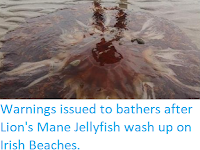Authorities in western Turkey have issued a warning to bathers after Compass Jellyfish, Chrysaora sp. (probably Chrysaora hysoscella), were spotted in the Dardanelles Strait close to the port of Çanakkale. The Jellyfish, which can deliver a sting comparable to that of a Bee, are not normally seen in the Dardanelles Strait, and people there may be unfamiliar with them. While individually the stings of these Jellyfish are comparatively mild, their tentacles can grow to a meter and a half in length, which often stick to their victims delivering multiple stings, and the stings will remain active when the Jellyfish have died, or the tentacles have become detached. If people are stung by these Jellyfish the recommendation is that the sting is treated with vinegar as quickly as possible - and not fresh water, which will make the sting worse.
Compass Jellyfish are native to the southern Mediterranean, but rising temperatures associated with global warming, combined with increased nutrient runoff, have enabled to spread northwards in the summer months, through the Dardanelles Strait into the Sea of Marmara and the Black Sea. There are concerns that a further temperature rises could lead to permanent populations becoming established in these areas, changing the ecology of these regions and damaging fisheries in the area.
Jellyfish, although often large, are entirely planktonic in nature, meaning that they simply drift in the water column, and are unable to swim against currents, so that storms or other events that cause temporary changes in current flow can deposit large numbers on shorelines. Jellyfish numbers are determined largely by nutrient availability, as nutrient levels determine the amount of phytoplankton (single-celled Algae) in the water column, and this in turn controls the numbers of smaller zooplankton (small planktonic Animals), which are the main source of food for Jellyfish.
See also...



Follow Sciency Thoughts on Facebook.
Follow Sciency Thoughts on Twitter.





